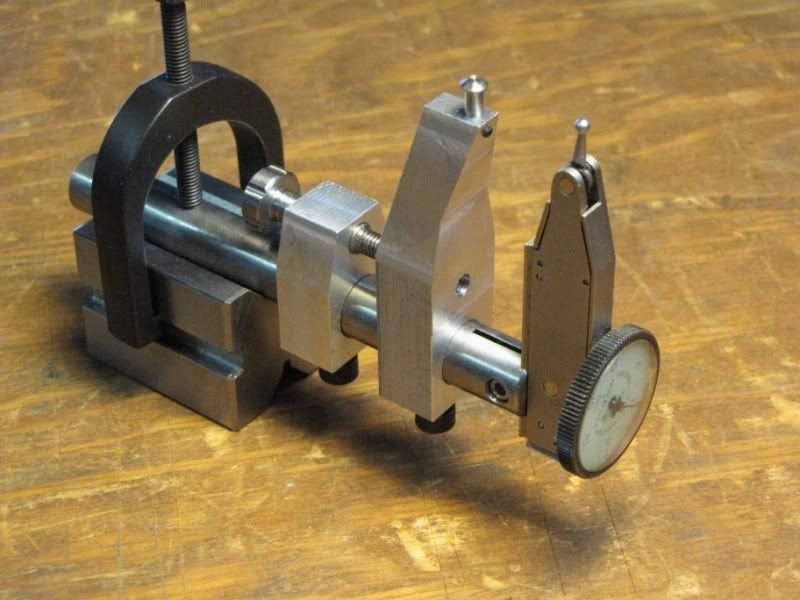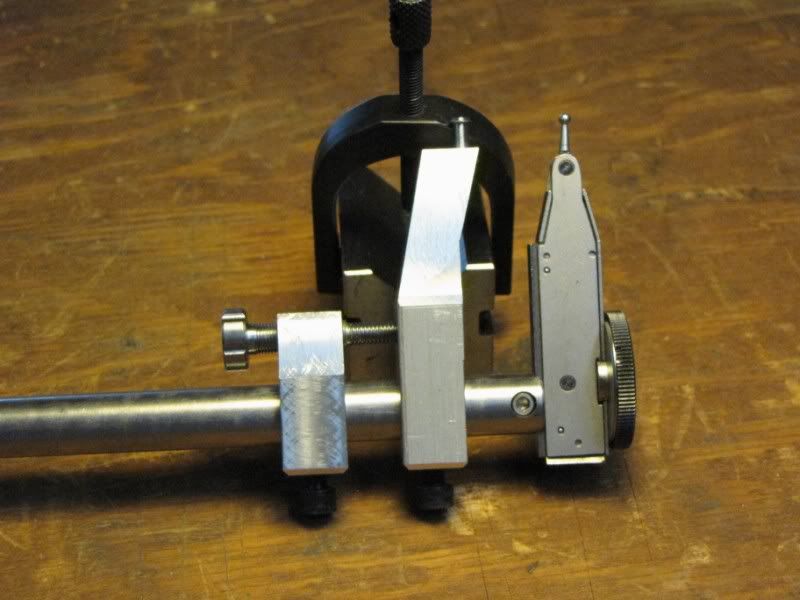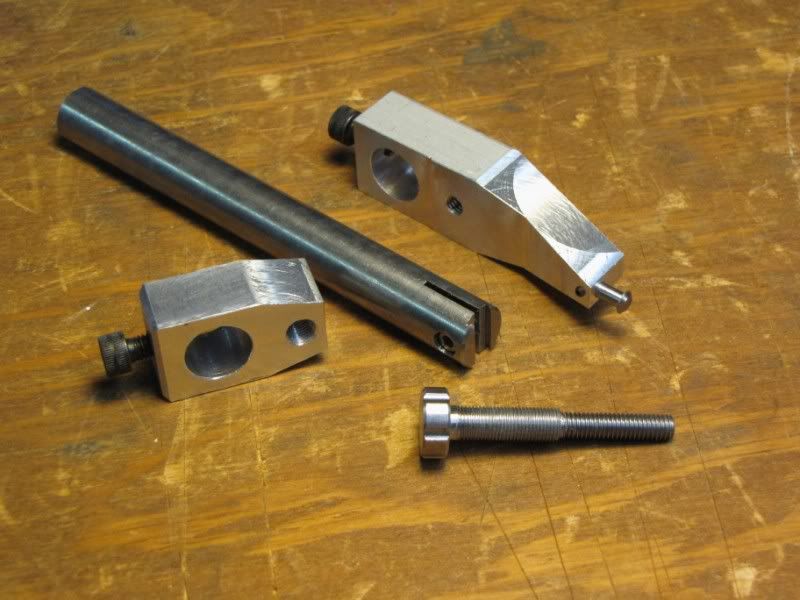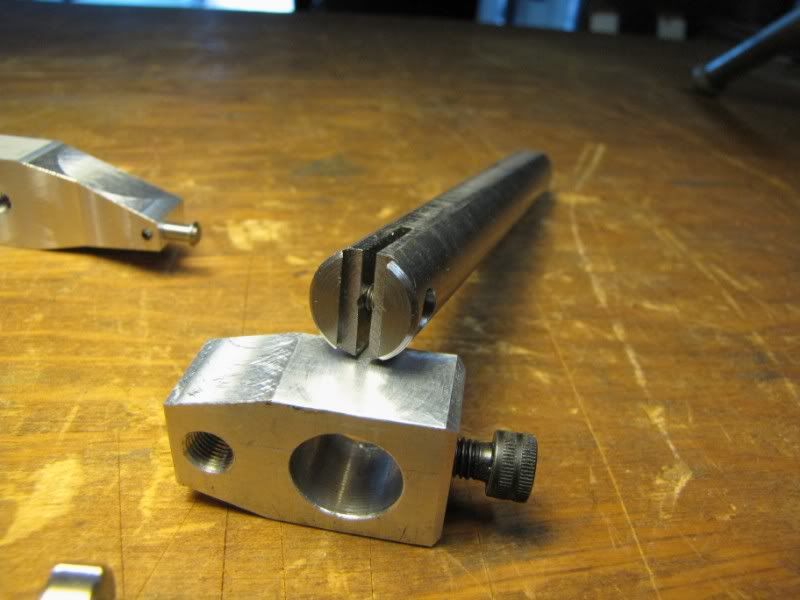mklotz
Well-Known Member
I was so impressed with George Britnell's gage for measuring bore sizes
http://www.homemodelenginemachinist.com/index.php?topic=5015.msg51407#msg51407
that I knew I had to make one of my own.
[Aside: Actually "impressed" is far too mild a term. After seeing it, it's just so obvious. We use a DTI that way on a height gage. How could I have been so dumb as to not see it myself. I'm annoyed with myself for not having thought of it myself. ]
]
I'm a real connoisseur of fine tools but I go absolutely gaga over homemade tools that aren't available in the market place. In fact, I was cutting metal the same day I saw George's post.
The first photo shows my efforts. Not quite as pretty as George's but functional nevertheless.

and a side view of the gage.

This tool cried out to me for a vernier fine adjustment and, feeling the need to personalize the project, I added one. It acts similar to the sort used on beam compasses but, instead of a simple threaded shaft uses a differential screw.
As is apparent in the next picture, the differential screw is threaded with two different threads. The body that threads into the vernier guide is 1/4-40 and the end which threads into the movable arm is threaded 10-32.
With this arrangement, one turn of the vernier adjustment knob will move the movable arm by:
1/32 - 1/40 = 1/160 = 0.00625"
the equivalent of a 160 tpi thread. With six notches on the knob, a one notch movement is very close to one thousandth of an inch movement.

The next photo shows the dovetail that secures the DTI in the end of the rod. To make it, I slotted with a 3/16" endmill to the correct depth and then cut the dovetail with a 1/4" dovetail cutter that I purchased from Brownells, the gunsmith suppliers in Iowa. Such tiny cutters are used to cut the dovetails used to secure the (adjustable) front sight on some types of firearms.
http://www.brownells.com/

[Another aside: As made, the adjusting screw is backwards. A clockwise turn of the screw will move the movable arm toward rather than away from the vernier guide. Were the 32 and 40 tpi sections reversed, this would be rectified but I was using dies and wanted a one piece screw so accepted the reversed movement which doesn't annoy me anyway. However, be warned if you make your own differential screws - think it through first.
If you want help with the mathematics of designing differential screws, there's a program on my page titled, surprisingly, DIFFTHRD that will be of assistance.]
Thanks for the idea, George. It's a real winner.
http://www.homemodelenginemachinist.com/index.php?topic=5015.msg51407#msg51407
that I knew I had to make one of my own.
[Aside: Actually "impressed" is far too mild a term. After seeing it, it's just so obvious. We use a DTI that way on a height gage. How could I have been so dumb as to not see it myself. I'm annoyed with myself for not having thought of it myself.
I'm a real connoisseur of fine tools but I go absolutely gaga over homemade tools that aren't available in the market place. In fact, I was cutting metal the same day I saw George's post.
The first photo shows my efforts. Not quite as pretty as George's but functional nevertheless.

and a side view of the gage.

This tool cried out to me for a vernier fine adjustment and, feeling the need to personalize the project, I added one. It acts similar to the sort used on beam compasses but, instead of a simple threaded shaft uses a differential screw.
As is apparent in the next picture, the differential screw is threaded with two different threads. The body that threads into the vernier guide is 1/4-40 and the end which threads into the movable arm is threaded 10-32.
With this arrangement, one turn of the vernier adjustment knob will move the movable arm by:
1/32 - 1/40 = 1/160 = 0.00625"
the equivalent of a 160 tpi thread. With six notches on the knob, a one notch movement is very close to one thousandth of an inch movement.

The next photo shows the dovetail that secures the DTI in the end of the rod. To make it, I slotted with a 3/16" endmill to the correct depth and then cut the dovetail with a 1/4" dovetail cutter that I purchased from Brownells, the gunsmith suppliers in Iowa. Such tiny cutters are used to cut the dovetails used to secure the (adjustable) front sight on some types of firearms.
http://www.brownells.com/

[Another aside: As made, the adjusting screw is backwards. A clockwise turn of the screw will move the movable arm toward rather than away from the vernier guide. Were the 32 and 40 tpi sections reversed, this would be rectified but I was using dies and wanted a one piece screw so accepted the reversed movement which doesn't annoy me anyway. However, be warned if you make your own differential screws - think it through first.
If you want help with the mathematics of designing differential screws, there's a program on my page titled, surprisingly, DIFFTHRD that will be of assistance.]
Thanks for the idea, George. It's a real winner.













![DreamPlan Home Design and Landscaping Software Free for Windows [PC Download]](https://m.media-amazon.com/images/I/51kvZH2dVLL._SL500_.jpg)


![MeshMagic 3D Free 3D Modeling Software [Download]](https://m.media-amazon.com/images/I/B1U+p8ewjGS._SL500_.png)


















![TurboCAD 2020 Designer [PC Download]](https://m.media-amazon.com/images/I/51UKfAHH1LL._SL500_.jpg)
































